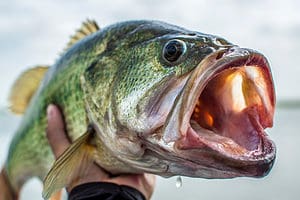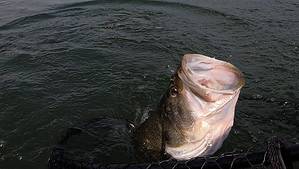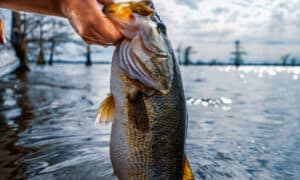The striped bass is the official state fish of Rhode Island. Depending on where you live, you may know it by a different name—striped bass, rockfish, stripers, lunkers, and linesiders are just a few. They can get quite sizeable and are a popular fish for anglers in Rhode Island, and many other coastal states.
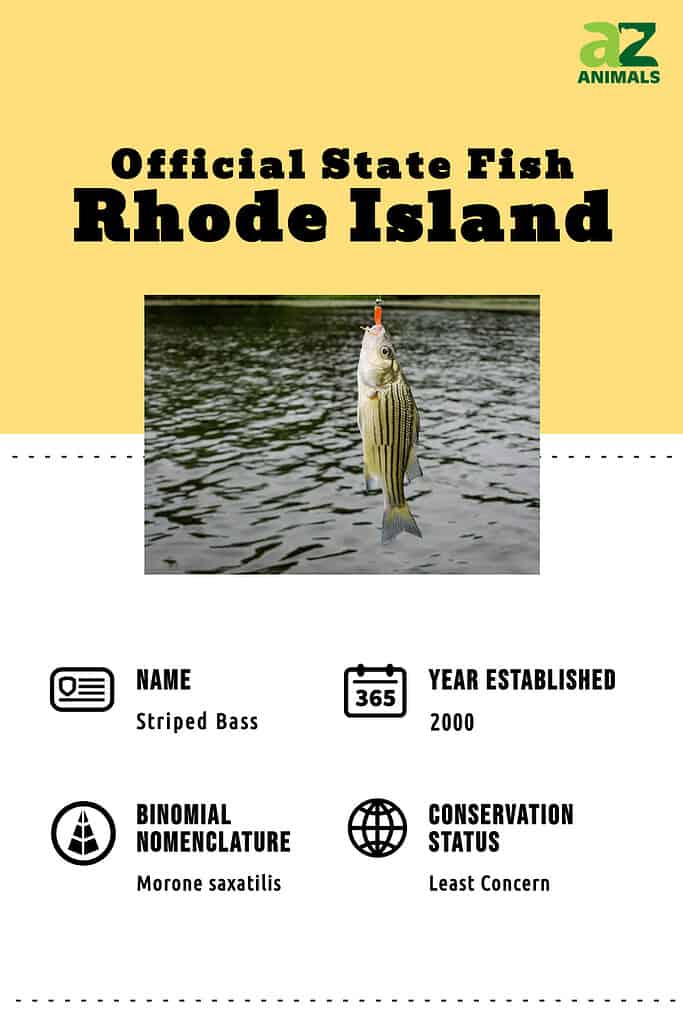
In 2000, the striped bass was adopted as the official state fish of Rhode Island, which makes it a relative newcomer to the many “official” animals of ‘Little Rhody.’ Striped bass range the entire east coast, from the southern tip of Florida’s peninsular state to Maine.
However, they are far more abundant in northern Atlantic Ocean waters, from North Carolina to Maine. Since Rhode Island sits comfortably in between the two, anglers get their fair share of striped bass. Though they are primarily saltwater fish, they are also comfortable moving up freshwater rivers and into brackish water as well.
History of the Official State Fish of Rhode Island
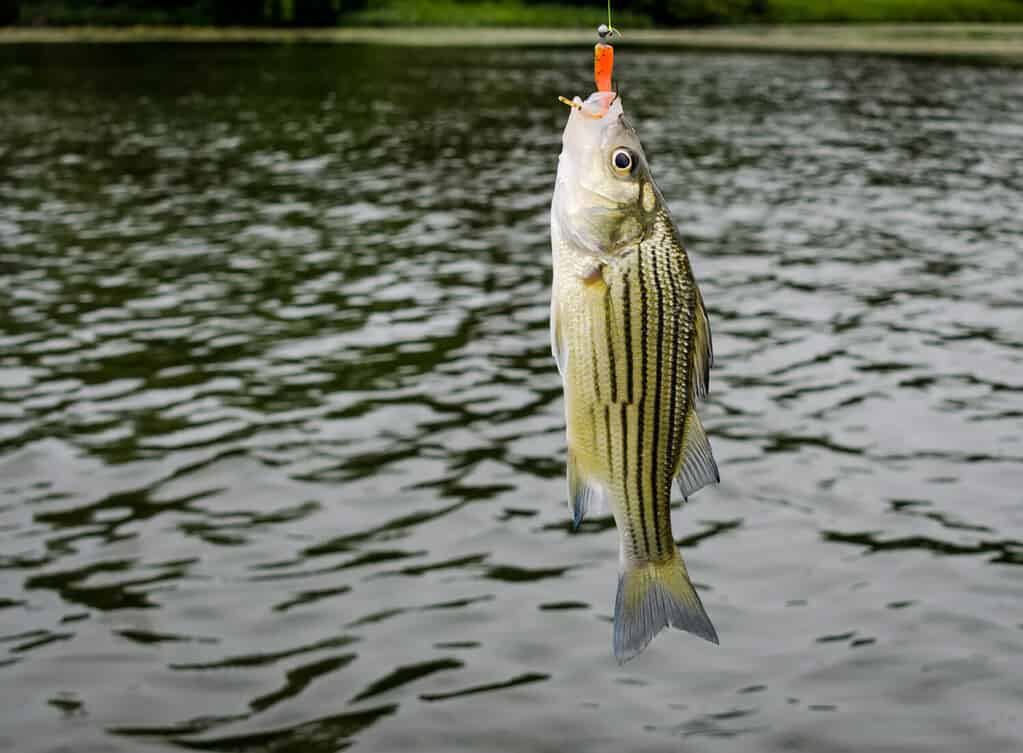
Striped bass caught on a river.
©HildeAnna/Shutterstock.com
Rhode Island’s official state page merely mentions the striped bass as the official fish of the state. However, it doesn’t delve into the details.
It’s the largest of the ‘sea bass’ family (Moronidae family) and is extremely popular with anglers. Overfishing is to the point where Rhode Island, among several other states, places regulations on how many anglers can take in at any given time.
According to the Cranston Herald, emergency action was taken in May of this year, to reduce the size limit from a maximum of 35″ to 31″. The minimum remains the same at 28″. Before May of this year, the typical limit on striped bass was 28″ to 25″ and anglers could only take home one.
Since the size limit is down to 28″ to 31″, the number of striped bass caught within the legal limits and kept will drop dramatically. Aside from the concern over the population numbers of striped bass, it remains an enormously popular fish.
Clarendon County, Rhode Island hosts a Striped Bass Festival once per year, always in the spring. Of course, you’ll find plenty of striped bass there. As it turns out, even with a pretty fierce regulation in force, there is still enough striped bass to go around.
Like the word “Hope” in the official state seal, there is no real history as to how and why the state chose the striped bass. However, seeing its popularity is enough to form annual festivals around, it’s not hard to see why it became so in the end.
Striped Bass Habits and Description
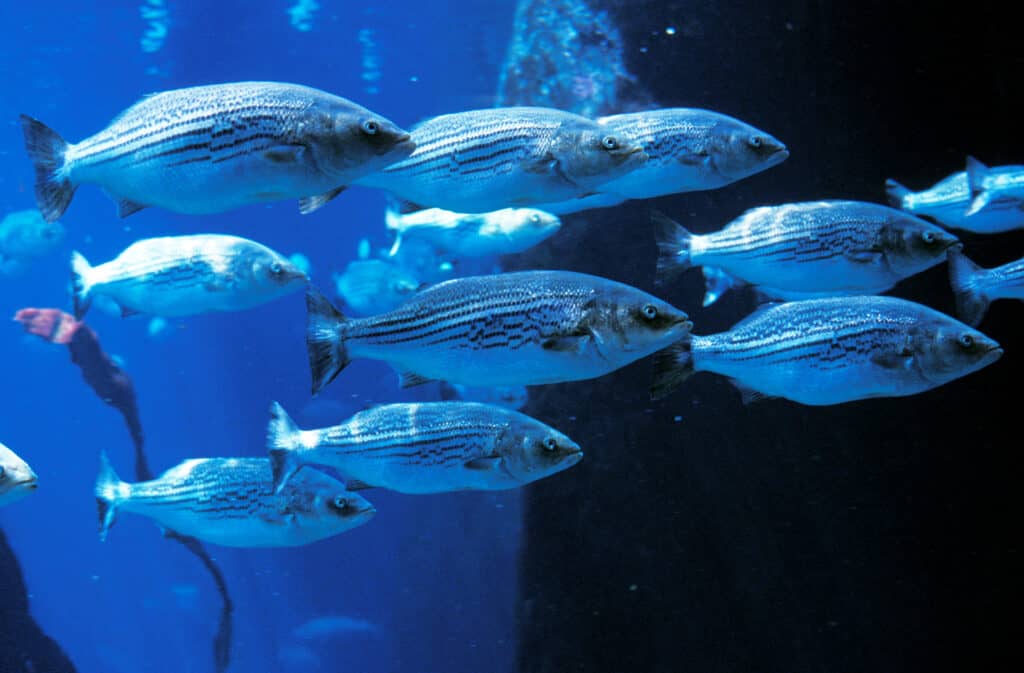
A shoal (school) of glue/silver striped bass swimming in an aquarium with a background that is very blue on the left side of the frame, and almost black on the right.
©slowmotiongli/Shutterstock.com
The official state fish of Rhode Island is anything if not recognizable. It gets its name from the distinct, black stripes that run the length of its body (usually 6 to 8 of them), starting behind the gills and only fading at the tail.
They grow quite large, though it takes a long time for them to reach their full potential. A striped bass averages between 20″ and 30″, though they can easily reach longer than 3′ at about the 7-year mark. Their lower jaws jut out a bit, longer and with more profile than the upper jaw and they are typically a light to olive green that fades into silver or pearl near the belly.
Altogether, not an ugly fish by any means, but not one that truly stands out from any other. When it comes to averages, the numbers are usually lower than what the fish is capable of growing to. Since there is a lot more juvenile and young adult striped bass out there than a veteran, elderly stripers, it skews the numbers a bit.
At full growth, however, a striper will weigh around 20 lbs, give or take a few pounds depending on its feeding success or failure. A striped bass will spend the vast majority of its life in the open ocean, but it will move into brackish or even freshwater at certain points each year.
Striped Bass Range
In the spring months, when inshore waters are between 55° and 67°F, adult stripers move into brackish waters or rivers and the spawning season begins. However, that’s usually the case for southern waters. As far north as Rhode Island, stripers won’t move in until around July.
At this point, male stripers engage in a ‘rock fight.’ This is mostly just a lot of thrashing around in the water while surrounding a female. Once her eggs are out, they become fertilized and drift for a time, usually about 3 to 4 days. Once the rock fight is over, the stripers head back out to sea.
So, if you’re on the lookout for striped bass this summer, expect them to head towards the shallower rivers, estuaries, and bays in July. They tend to start moving north in May and will remain in northern waters until as late as October, though they often start moving south again in September.
When fishing for striped bass, they are most often found in rock areas, in the bays and rivers in July, along with salt ponds. Soft plastics are a particular favorite, along with poppers. As far as live bait, stripers prefer eels and menhaden.
During the spawn, trolling back in from a day out on the ocean, squid lures and umbrella rigs are fairly popular and highly successful. Stripers are generally opportunistic and spend plenty of time at the top of the water column, making trolling a pretty effective method for catching them.
Final Thoughts on Rhode Island’s Official State Fish
While there’s not a lot of information out there on the history of the choice, there’s little doubting the popularity of the state fish of Rhode Island. Striped bass are so popular that they are largely overfished. Unfortunately, that’s caused a crackdown on the regulatory side of things, reducing the size limitations to a narrowly defined number.
The striped bass is also the state fish of South Carolina, Maryland, New Jersey, New Hampshire, Virginia, and New York, further emphasizing the popularity of the striped bass.
The photo featured at the top of this post is © slowmotiongli/Shutterstock.com
Thank you for reading! Have some feedback for us? Contact the AZ Animals editorial team.



